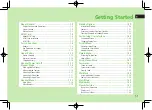
R E G U L A T O R Y A N D S A F E T Y I N F O R M A T I O N
340
•
Do not short-circuit a battery or allow metallic conductive objects
to contact battery terminals.
•
Replace the battery only with another battery that has been
qualified with the system per IEEE/CTIA-1725. Use of an
unqualified battery may present a risk of fire, explosion, leakage
or other hazard.
•
Promptly dispose of used batteries in accordance with local
regulations.
•
Battery usage by children should be supervised.
•
Avoid dropping the phone or battery. If the phone or battery is
dropped, especially on a hard surface, and the user suspects
damage, take it to a service center for inspection.
•
Do not handle a damaged or leaking lithium-Ion (li-ion) battery as
you can be burned.
•
Improper battery use may result in a fire, explosion or other
hazard.
Based on DOT rules, spare batteries must not be transported in
checked luggage on commercial flights. Spare batteries can only be
transported in carry-on luggage. For more information:
http://safetravel.dot.gov/whats new batteries.html.
Protecting Your Battery
The guidelines listed below help you get the most out of your
battery’s performance.
Recently there have been some public reports of wireless phone
batteries overheating, catching fire, or exploding. It appears that
many, if not all, of these reports involve counterfeit or inexpensive,
aftermarket-brand batteries with unknown or questionable
manufacturing standards. Use only manufacturer-approved batteries
and accessories found at Carrier Stores or through your device’s
manufacturer. Buying the right batteries and accessories is the best
way to ensure they're genuine and safe.
•
In order to avoid damage, charge the battery only in temperatures
that range from 32° F to 122° F (0° C to 50° C).
•
Don’t use the battery charger in direct sunlight or in high humidity
areas, such as the bathroom.
•
Never dispose of the battery by incineration.
•
Keep the metal contacts on top of the battery clean.
•
Don’t attempt to disassemble or short-circuit the battery.
•
The battery may need recharging if it has not been used for a long
period of time.
•
It’s best to replace the battery when it no longer provides
acceptable performance. It can be recharged hundreds of times
before it needs replacing
•
Don’t store the battery in high temperature areas for long periods
of time. It’s best to follow these storage rules:
•
Less than one month: 14° F to 140° F (–10° C to 60° C)
•
More than one month: 14° F to 113° F (–10° C to 45° C)
Power Specifications
Use only power accessories approved by Palm, such as AC-power
adapters and batteries. Unauthorized and non-approved batteries will
NOT operate with the Palm smartphone.
AC Power Adapter source:
Foxlink
Model: 5890-712V-02K0
Part Number: 157-10108-00
Input Rating: 100–240 Vac, 50/60Hz, 0.2A
Output Rating: 5Vdc, 1000mA
Battery Source:
Palm
Type: Rechargeable Li-ion Polymer
Model: 157-10105-00
Rating: 3.7Vdc, 1500mAh (minimum)
Recycling and Disposal
This symbol indicates that Palm products should be
recycled and not be disposed of in unsorted
municipal waste. Please return Palm products to the
electrical and electronic equipment collection points
in your municipality or county. These collection
points are available free of charge. For detailed
Summary of Contents for Treo Pro
Page 1: ...User Guide ...
Page 7: ...C O N T E N T S vii Regulatory and safety information 337 Specifications 349 Index 353 ...
Page 8: ...C O N T E N T S viii ...
Page 14: ...W E L C O M E W H E R E C A N I L E A R N M O R E 14 1 C H A P T E R ...
Page 26: ...S E T T I N G U P S E T T I N G U P S Y N C H R O N I Z A T I O N 26 2 C H A P T E R ...
Page 208: ...In this chapter Contacts 209 Calendar 212 Tasks 219 Notes 222 ...
Page 347: ...R E G U L A T O R Y A N D S A F E T Y I N F O R M A T I O N 347 www palm com recycle ...
Page 348: ...R E G U L A T O R Y A N D S A F E T Y I N F O R M A T I O N 348 ...
Page 386: ...I N D E X 386 ...
Page 387: ......
Page 388: ...Palm Inc 950 W Maude Ave Sunnyvale CA 94085 2801 United States of America ...
















































